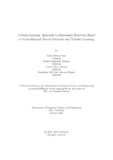| dc.contributor.advisor | Parvez, Dr. Mohammad Zavid | |
| dc.contributor.author | Sarmi, Kaniz Fatima | |
| dc.contributor.author | Rahman, Shaikh Mahmudur | |
| dc.contributor.author | Sultana, Nusrat Jahan | |
| dc.contributor.author | Anzoom Shanto, Khandaker MD. Asef | |
| dc.date.accessioned | 2022-11-16T04:50:33Z | |
| dc.date.available | 2022-11-16T04:50:33Z | |
| dc.date.copyright | 2021 | |
| dc.date.issued | 2021-10 | |
| dc.identifier.other | ID: 17102040 | |
| dc.identifier.other | ID: 17101338 | |
| dc.identifier.other | ID: 17101331 | |
| dc.identifier.other | ID: 17101248 | |
| dc.identifier.uri | http://hdl.handle.net/10361/17576 | |
| dc.description | This thesis is submitted in partial fulfillment of the requirements for the degree of Bachelor of Science in Computer Science and Engineering, 2021. | en_US |
| dc.description | Cataloged from PDF version of thesis. | |
| dc.description | Includes bibliographical references (pages 42-48). | |
| dc.description.abstract | Depression and mental health issues (stress, nervousness, panic attacks, anxiety
attacks etc.) are nowadays a major issue in the whole world. It is a common cause
of mental illness that has been linked to an increased risk of dying young. Especially
in our country, mental health is an issue which most of the families do not want
to give as much attention as it is supposed to get and because of that so many
people who are suffering from Major Depressive Disorder (MDD) are often helpless.
Currently there are numerous ways to detect depression by various methods. For
example: emotion recognition, social media records, analyzing daily routine with the
help of machine learning and many more. This paper aims to detect depression by
implementing various deep learning/ transfer learning models (for example: VGG16,
Xception, ResNet152, MobileNetV2 etc.) using EEG brain signals to discover the
model that provides the highest level of accuracy for our data type. In addition, we
want to analyze why the particular model performs better and what might be the
cases to make a model perform better to propose a model so that this method of
modeling can be used in most cases for detecting depression and model improvement.
Furthermore, we have made a custom model which gives the most accuracy (99.75%).
We are successful at bringing the highest accuracy among the existing models which
were implemented by us. For this reason, we are analyzing the EEG brain signal
data of several healthy and MDD patients. We believe that this research will aid in
the development of innovative strategies for building models and early identification
of depression in our daily lives. | en_US |
| dc.description.statementofresponsibility | Kaniz Fatima Sarmi | |
| dc.description.statementofresponsibility | Shaikh Mahmudur Rahman | |
| dc.description.statementofresponsibility | Nusrat Jahan Sultana | |
| dc.description.statementofresponsibility | Khandaker MD. Asef Anzoom Shanto | |
| dc.format.extent | 48 Pages | |
| dc.language.iso | en_US | en_US |
| dc.publisher | Brac University | en_US |
| dc.rights | Brac University theses are protected by copyright. They may be viewed from this source for any purpose, but reproduction or distribution in any format is prohibited without written permission. | |
| dc.subject | Electroencephalogram (EEG) | en_US |
| dc.subject | Major Depressive Disorder (MDD) | en_US |
| dc.subject | Brain Signal Analysis | en_US |
| dc.subject | Transfer Learning Models | en_US |
| dc.subject | VGG16 | en_US |
| dc.subject | ResNet152 | en_US |
| dc.subject | Xception | en_US |
| dc.subject | MobileNetV2 | en_US |
| dc.subject | Machine Learning | en_US |
| dc.subject.lcsh | Machine Learning | |
| dc.subject.lcsh | Electroencephalography | |
| dc.subject.lcsh | Neural networks (Computer science) | |
| dc.title | A deep learning approach to depression detection based on Convolutional Neural Networks and Transfer Learning | en_US |
| dc.type | Thesis | en_US |
| dc.contributor.department | Department of Computer Science and Engineering, Brac University | |
| dc.description.degree | B. Computer Science | |

